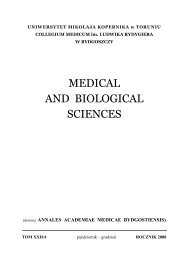Medical and Biological Sciences XXVI/2 - Collegium Medicum ...
Medical and Biological Sciences XXVI/2 - Collegium Medicum ...
Medical and Biological Sciences XXVI/2 - Collegium Medicum ...
Create successful ePaper yourself
Turn your PDF publications into a flip-book with our unique Google optimized e-Paper software.
8<br />
Julia Feit et. al.<br />
individuals, who are not carriers of the virus, does not<br />
differ statistically significantly from drug addicts who<br />
are HIV positive.<br />
putamen) <strong>and</strong> functionally being a central structure of<br />
the limbic system <strong>and</strong> reward system [19].<br />
However, increasing the motor performance of<br />
HIV(+) individuals may be influenced by many<br />
pharmacokinetic factors.<br />
Antiviral medicines often interact with methadone<br />
due to the complex metabolism which may lead to<br />
intensified adverse events including reduction or<br />
potentiating of the effectiveness of methadone.<br />
The pharmacokinetic properties of the same drug<br />
can vary considerably between patients due to genetic<br />
factors or comorbidities including liver damage<br />
associated with HCV <strong>and</strong> HBV infection. Those are<br />
very common in this group of patients. All of these<br />
medications interact with methadone <strong>and</strong> antiviral<br />
drugs [20, 21, 22, 23].<br />
Fig. 3. The comparison of execution time TMT A test before<br />
<strong>and</strong> after the administration of a single dose of<br />
methadone in the group of HIV(+)<br />
Ryc. 3. Porównanie czasu wykonania testu TMT A przed i po<br />
podaniu metadonu w grupie osób HIV(+)<br />
DISCUSSION<br />
The study aimed to verify the effect of a single dose<br />
of methadone on the motor skills of HIV(+) persons<br />
addicted to opioids in comparison to HIV(-) ones. In<br />
addition, the TMT test examined whether its values<br />
depend on the dose of methadone taken <strong>and</strong> the<br />
duration of treatment.<br />
It was found that there are statistically significant<br />
differences both in the speed of TMT A test<br />
completion <strong>and</strong> in the duration of methadone<br />
treatment.<br />
However, this does not mean that there is<br />
a correlation between these results, because the<br />
duration of the treatment may be associated with a<br />
virus carrier status, which is associated with the risk of<br />
loss of life, <strong>and</strong> what therefore motivates people in this<br />
group for a systematic substitution therapy.<br />
The time of completion of the TMT A test in<br />
subjects from both groups may be related to the<br />
influence of psychoactive substances in the nervous<br />
centers [18,9]. It was found that in people addicted to<br />
psychoactive substances, structural <strong>and</strong> functional<br />
changes take place in the ventral striatum. The major<br />
part of which is the nucleus accumbens anatomically a<br />
part of the striatum (including caudate nucleus <strong>and</strong><br />
CONCLUSION<br />
Based on the analysis of the test results in opioid<br />
addicted subjects, who are participants of the<br />
methadone program, before <strong>and</strong> after the<br />
administration of a therapeutic dose of methadone, it<br />
can be concluded that the adoption of a therapeutic<br />
dose of methadone statistically significantly increases<br />
psychomotor performance.<br />
The size of methadone dose does not influence the<br />
study results. The duration of treatment, which is<br />
statistically significantly longer in HIV(+) individuals,<br />
can be determined by a life-threatening risk in this<br />
group. A single dose of methadone statistically<br />
significantly affects motor functions of HIV(+)<br />
subjects.<br />
REFERENCES<br />
1. Anthony J. C., Warner L., Kessler R. Comparative<br />
epidemiology of dependence on tabacco, alcohol,<br />
controlled substances <strong>and</strong> inhalants: Basic findings<br />
from the National Comorbidity Survey. Experimental<br />
<strong>and</strong> Clinical Psychopharmacology 1994, 2(3), 244-68.<br />
2. Teesson M., Hall W., Degenhardt L. Uzależnienia -<br />
Modele kliniczne i techniki terapeutyczne. GWP,<br />
Gdańsk, 2005.<br />
3. Connor M., Christie MD. Opioid receptor signalling<br />
mechanisms. Clin.Exp. Pharmacol. Physiol. 1999, 26,<br />
493-9.<br />
4. Law P.Y., Wong Y.H., Loh H.H. Molecular<br />
mechanisms <strong>and</strong> regulationof opioid receptor signaling.<br />
Annu. Rev. Pharmacol. Toxicol. 2000, 40, 389–430.<br />
5. Ross S., Peselow E. The neurobiology of addictive<br />
disorders. Clin Neuropharmacol. 2009, 269-76.

















